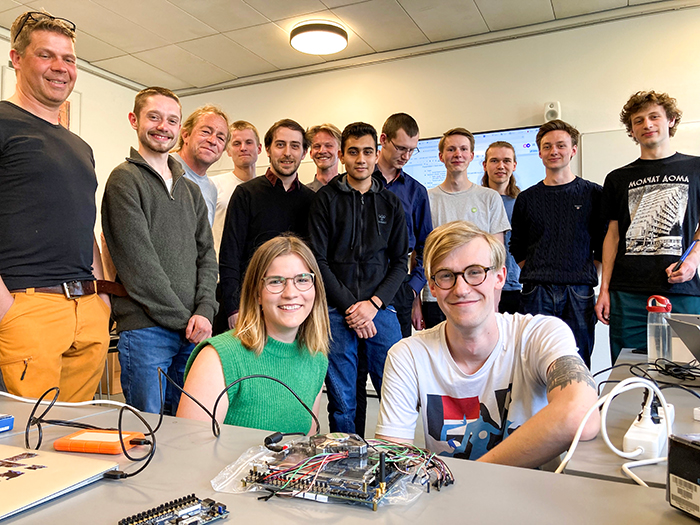Twelve students have designed a chip with free software, and it is being manufactured in the United States at no cost through a Google initiative.
There is always a festive atmosphere at DTU when the students complete a 13-week semester. This spring, 12 students will furthermore write history at DTU Compute. Since February, they have been following a special course in chip design.
The course is historic for several reasons: It is the first time that DTU teaches chip design as a semester subject for bachelor's and master's students. It is also the first time that open source tools have been used to design the microchip. In addition, the chip will be produced free of charge in the USA during the summer and sent to Denmark, so DTU has the chance to test whether it really works.
"For years, we have talked about open source software. Now comes open source hardware. It is groundbreaking that we can use free tools to design the chip. Because usually, it is so expensive to buy licenses for the various tools you use to make a microchip that only companies have had the opportunity to do so,” explains Professor Martin Schoeberl. He leads the course together with Assistant Professor Luca Pezzarossa.
“It is impressive and inspiring to see how a relatively small group of BSc students can work together on the difficult challenges associated with the chip design process, and produce concrete results in such a short amount of time. In addition to the chip design process, the students learn the value of constructive teamwork, which I believe is a fundamental skill for future engineers," says Luca Pezzarossa.
"Chip design is the best"
When you want to work with digital electronics, it is an advantage to have an electrical background, so you have in-depth knowledge of electrical circuits, and so on, before you work with computer science. The 12 students all come from DTU Electrical Engineering.
On the course, the students are divided into small groups. The groups are in charge of the many different parts of the process of chip design, how it works, and so on. All but one of the students is studying for a bachelor’s degree. One of them is Christa Skytte Jensen, who is writing her bachelor thesis on algorithms and data structure during the 6th semester:
“I imagine that I want to work with chip design, and therefore the course is a nice way to get some insight into the area. We are all beginners and learn in step with each other and get an overall picture of what it is all about.”
"For years, we have talked about open source software. Now comes open source hardware. It is groundbreaking that we can use free tools to design the chip. Because usually, it is so expensive to buy licenses for the various tools you use to make a microchip that only companies have had the opportunity to do so."
Professor Martin Schoeberl, the research section Embedded Systems Engineering at DTU Compute
Karl Herman Krause is studying in the 4th semester at DTU Electrical Engineering. He has already worked a lot with digital electronics and computer architecture, which is somewhat reminiscent of chip design:
“I have always been interested in chip design. I think much of my life has been marked by digital electronics. The world is changing very quickly, and the digital electronics set the pace for how other technologies evolve. So the idea of being able to play a role in it in the future is really fascinating and super exciting.”
Need for innovation in Denmark
The EU wants to bring chip design and production back to Europe and wants to raise 43 billion euros in public and private investment through the EU Chips Act. Recently, DTU Compute together with the microchip industry held a well-attended career day - DTU Chip Day - where the message from the 20 companies to the many students was: There are plenty of vacancies in chip design in Denmark.
The lack of staff contributes to the fact that Jørgen Kragh Jakobsen, who is an analogue circuit designer and owner of the one-man company IC Works, has suggested that Martin Schoeberl and Luca Pezzarossa set up the special course to increase young people's interest in chip design. And he even helps out on the course for free.
"We need innovation in this area. And the special course here is the first generation of some chip designers working with open source tools. We have not seen that before. And it will explode over the next few years,” says Jørgen Kragh Jakobsen.
“It is very important that the students get hands-on experience so they get to know the process of designing a chip that should be able to do different things, and later get the manufactured chip to find out if the works. That is how we do in the industry. That is why it is nice to see the bachelor students gain practical experience with this,” he says.

The group on April 29, 2022. Credit: Hanne Kokkegård